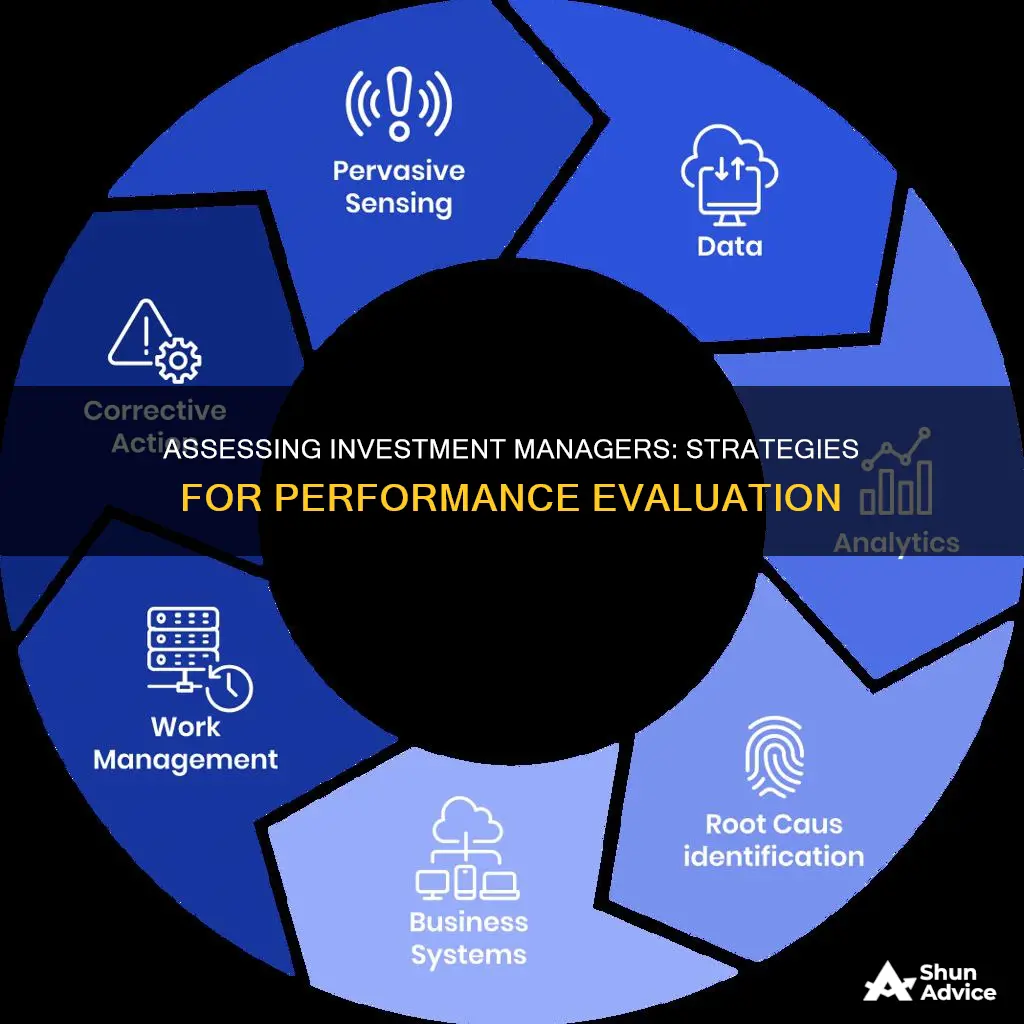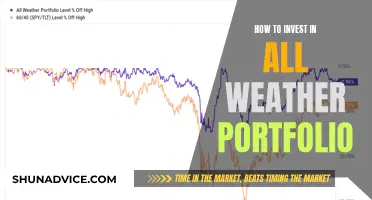
There are several ways to judge the performance of an investment manager. One way is to look at the overall performance of the portfolio they manage. However, total return cannot be the only metric used to determine whether an investment manager is doing their job effectively. For instance, a 2% annual total portfolio return may seem small, but if the market only increased by 1% during the same period, then the portfolio performed well. Another way to judge an investment manager's performance is by comparing the risk-adjusted return of an investment portfolio. This can be done using ratios such as the Sharpe ratio, Roy's safety-first ratio, the Sortino ratio, the Treynor ratio, and the information ratio. These ratios help investors calculate the excess return per unit of risk. Additionally, it is important to consider the fees charged by the investment manager, as these can impact the overall return. Finally, it is crucial to understand the investor's risk tolerance and goals when evaluating the performance of an investment manager.
| Characteristics | Values |
|---|---|
| Absolute return | The return generated in a portfolio over a given time frame, taking into account investor contributions and withdrawals |
| Relative return | The absolute return of the portfolio compared to an appropriate benchmark |
| Sharpe ratio | The excess return of the portfolio over a risk-free rate, standardised by the standard deviation of the excess portfolio return |
| Roy's safety-first ratio | Similar to the Sharpe ratio but compares portfolio returns to a target return, rather than a risk-free rate |
| Sortino ratio | Similar to Roy's safety-first ratio but only includes downside volatility in the calculation |
| Treynor ratio | Calculates the additional portfolio return over the risk-free rate, using beta as the risk measure |
| Information ratio | Reflects the manager's stock-picking abilities by measuring the return above the benchmark, using the standard deviation of active returns as a measure of risk |
| Return on capital employed (ROCE) | Compares the profits earned by the investment centre to the capital invested |
| Residual income (RI) | Makes a notional charge to the investment centre for its use of capital, reflecting the cost of supplying divisions with capital |
What You'll Learn

Compare the manager's performance to broad indexes
When evaluating the performance of an investment manager, it is important to compare their performance to broad indexes. This allows you to assess how well they are capturing market returns relative to a benchmark. Here are some key considerations when making this comparison:
- Absolute and Relative Returns: Absolute return refers to the net return generated in the portfolio over a given time frame, considering any contributions or withdrawals. Relative return, on the other hand, involves comparing the absolute return to a relevant benchmark, such as the S&P 500 for US stocks. This helps evaluate how effectively the manager is capturing market returns.
- Appropriate Benchmarks: Ensure that the chosen benchmark aligns with the strategic allocation of the portfolio. For example, if US stocks comprise 40% of the portfolio's allocation, the benchmark should include a 40% weighting in a US stock benchmark. This ensures an "apples-to-apples" performance comparison.
- Risk-Adjusted Performance: Consider comparing the risk-adjusted performance of the manager to the relevant benchmark. This can be done using statistics such as the Sharpe ratio, which takes into account the return of the portfolio in excess of a risk-free return (usually a 90-day Treasury bill) and divides it by the standard deviation (volatility) of the portfolio returns.
- Manager Fees: Remember to account for manager fees when evaluating performance. These fees impact the overall return and can be a significant factor in the long-term growth of the portfolio.
- Consistency: Evaluate the consistency of the manager's performance over time. Look for managers who consistently outperform their benchmarks and have navigated through various market conditions, including downturns.
- Qualitative Factors: While quantitative comparisons are important, they are not the only factor to consider. There are also qualitative aspects to evaluating investment managers, such as their investment strategy, experience, and client service.
By comparing the investment manager's performance to broad indexes and considering the above factors, you can gain a more comprehensive understanding of their effectiveness and make more informed decisions about your investments.
Loans: Saving or Investing? Understanding the Financial Impact
You may want to see also

Understand risk-adjusted returns
When judging the performance of an investment manager, it is important to understand risk-adjusted returns. This is because it allows you to measure an investment's return by examining how much risk was taken to obtain that return.
There are several methods for evaluating risk-adjusted returns, such as the Sharpe and Treynor ratios, alpha, beta, and standard deviation. Each method yields a slightly different result, so it is important to be clear on the type of risk-adjusted return being considered.
The Sharpe ratio, for example, measures the profit of an investment that exceeds the risk-free rate per unit of standard deviation. A higher Sharpe ratio is preferable as it indicates a better risk-return scenario.
The Treynor ratio is calculated in the same way as the Sharpe ratio but uses the investment's beta in the denominator. Like the Sharpe ratio, a higher Treynor ratio is better.
Alpha is a measure of an investment's return in relation to a benchmark, such as the Sensex or Nifty. A positive alpha indicates that the investment is outperforming the benchmark.
Beta is a measure of volatility and indicates how much risk is involved in an investment compared to the broader market. A beta value higher than 1 indicates that the investment is more volatile than the market.
Standard deviation measures how much an asset's returns vary over an observed period compared to its average returns, providing insight into the steadiness of an asset's returns.
By using these methods to understand risk-adjusted returns, investors can make more informed decisions about their investments and better evaluate the performance of investment managers.
Investment Management Fees: Are They Deductible on Form 1041?
You may want to see also

Assess the manager's fees
When assessing the fees charged by an investment manager, it is important to consider the impact of these fees on overall returns. While higher fees do not necessarily indicate inferior service, they can affect the real rate of return. Therefore, it is advisable to compare the fees charged by different managers offering similar services. This allows you to determine if the fees are reasonable for the type of investment strategy and level of management provided.
Additionally, it is worth noting that the fees charged by investment managers can vary depending on the size of the portfolio. Larger portfolios may benefit from lower fees due to a sliding scale applied by some managers. When evaluating the fees, consider your portfolio size and the corresponding fee structure to ensure a fair comparison.
To calculate the impact of fees on returns, you can use the following formula:
> Annualized return after fees = Annualized return before fees - Fees
For example, if a manager has generated a return of 5.06% before fees and charges a fee of 0.15%, the return after fees would be 4.91% (5.06% - 0.15% = 4.91%). This calculation helps you understand the net return generated by the manager, taking into account the fees deducted from the overall return.
It is also important to remember that past performance does not guarantee future results. However, by considering the historical returns and fees of an investment manager, you can gain insights into their ability to generate returns while managing costs. This analysis can help you make a more informed decision about whether to engage or retain a particular investment manager.
Furthermore, it is worth noting that investment managers may have different fee structures, such as a flat fee or a percentage of the portfolio value. Understanding the fee structure and calculating the impact on returns can help you assess the value provided by the manager relative to the fees they charge.
The Cycle of Savings, Borrowing, and Investing: Understanding the Trio
You may want to see also

Measure absolute and relative returns
When judging the performance of an investment manager, it is important to consider both absolute and relative returns. Absolute return is the return that an asset achieves over a specified period. It looks at the appreciation or depreciation of an asset, such as a stock or mutual fund, expressed as a percentage over a given period. Absolute return fund managers are focused on shorter-term results and aim to develop a diversified portfolio that is not subject to wild swings due to market events. They employ various strategies, such as short selling, futures, options, derivatives, arbitrage, leverage, and investing in unconventional assets.
On the other hand, relative return is the difference between the absolute return and the performance of the market or similar investments, measured against a benchmark or index, such as the S&P 500. Relative return, also called alpha, is important because it helps measure the performance of actively managed funds, which should ideally earn returns greater than the market. Relative return is a way to gauge a fund manager's performance and determine if they are delivering returns commensurate with the investor's risk exposure.
For example, consider a mutual fund with a current value of Rs 10,000 and an investment value of Rs 8,000. The absolute return would be (10,000-8,000)/8,000, resulting in a 25% return. However, to evaluate the fund manager's performance, we need to calculate the relative return by comparing it to a benchmark index. Let's say the benchmark index returned 0.4% in three months. The relative return for this mutual fund would be (0.5%-0.4%) = 0.1% for the same period.
Another example is the Vanguard 500 Index ETF (VOO), which delivered an absolute return of 150.15% over a 10-year period ending December 31, 2017. However, when compared to the S&P 500 Index's absolute return of 153.07% during the same period, the relative return was calculated as -2.92%. This indicates that the fund underperformed the benchmark by 2.92%.
In summary, absolute return provides the raw data of an investment's performance, while relative return puts that data into context by comparing it to relevant benchmarks and indices. Both are essential for investors to understand the performance of their investments and make informed decisions about their investment strategies and fund managers.
Investment Management: Competitive or Cutthroat?
You may want to see also

Evaluate the manager's stock-picking abilities
When evaluating an investment manager's stock-picking abilities, it's important to consider various factors and metrics that indicate their performance and decision-making skills. Here are some key points to keep in mind:
- Risk-Adjusted Performance: It's essential to assess the manager's ability to generate returns while managing risk effectively. This involves calculating the excess return of the portfolio over a risk-free rate, such as government bonds, and standardizing it by the standard deviation of the portfolio. The Sharpe ratio is a commonly used metric for this purpose.
- Comparison to Broad Indexes: Compare the manager's performance to broad market indexes such as the S&P 500. While it's not a perfect indicator, if the manager consistently underperforms the market, it could be a cause for concern.
- Fees and Costs: High fees charged by investment managers can eat into the overall returns. It's important to evaluate if the manager's performance justifies the fees they charge.
- Consistency and Time Horizon: Look at the manager's performance over a longer time period to assess consistency. Short-term gains may not be indicative of long-term success.
- Understanding Investor Goals: A good investment manager should have a clear understanding of their client's risk tolerance, investment goals, and time horizon. Their stock-picking decisions should align with these factors.
- Strategy and Research: Evaluate the manager's stock-picking strategy and the research that goes into their decisions. Consider their ability to interpret market data, stay updated with industry news and trends, and make informed choices.
- Performance in Different Market Conditions: Assess how the manager's stock picks perform during different market conditions, such as bullish or bearish markets. A good manager should be able to adapt their strategy accordingly.
- Specialization and Expertise: Consider the manager's expertise in specific industries or sectors. Some managers may have a stronger track record in certain areas, which could influence their stock-picking abilities in those sectors.
By considering these factors and analysing the manager's historical performance, you can gain insights into their stock-picking abilities and make a more informed decision about their effectiveness.
Savings-to-Investment Ratio: A Window to Your Financial Health
You may want to see also
Frequently asked questions
You can compare the total return of your portfolio to a relevant benchmark, such as the S&P 500, Dow Jones Industrials Average Composite, or Nasdaq. However, it's important to remember that these benchmarks may not be appropriate for a balanced portfolio that includes bonds and other asset classes. A more accurate comparison would be to ensure the benchmark mirrors the strategic allocation of the portfolio.
A benchmark is a standard against which the performance of a security, mutual fund, or investment manager can be measured. Generally, a benchmark is a broad-based index or an average of unmanaged funds.
A balanced portfolio is one that includes a mix of asset classes, such as stocks, bonds, and other investments, to help diversify risk and maximize returns.
Investment managers are charged with capturing returns effectively, but they cannot create returns. They employ different strategies, such as actively managed or passively managed approaches, to attempt to capture positive returns.
The manager of an investment centre has control over cost, revenue, and investments in operating assets. Performance measures include Return on Capital Employed (ROCE) and Residual Income (RI). ROCE compares the profits earned by the investment centre to the capital invested, while RI makes a notional charge to the investment centre for its use of capital.







